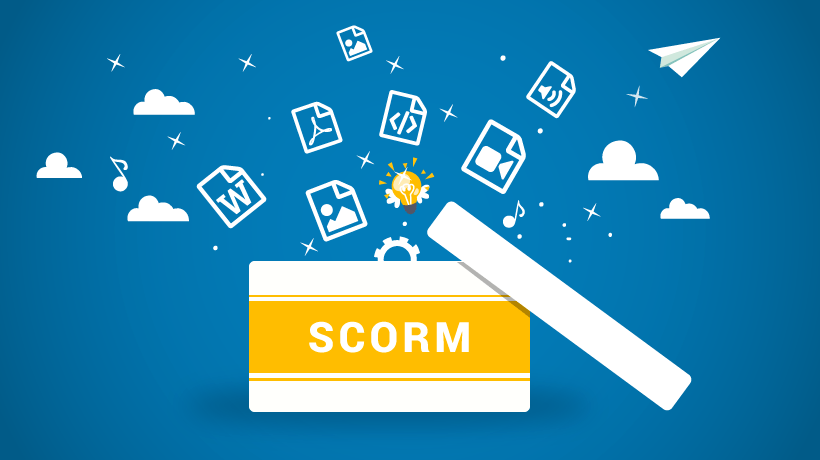A Comprehensive Guide On SCORM And Its Use In eLearning
In eLearning, SCORM (Sharable Content Object Reference Model) has emerged as a game-changer. It offers a standardized way to create, deliver, and track learning content. Whether you're developing an online course, deploying an eLearning program, or selecting a Learning Management System (LMS), understanding this model is essential. Let's take a deep dive into SCORM and understand what it is, how it works, its benefits and challenges, and the tools you need to implement it.
What's In This Guide...
What Are The Different SCORM Versions?
What You Can Track With SCORM Versions 1.2 And 2004
How Can I Create A SCORM File?
SCORM Compliance Testing: Tools And Methods
What Are The Benefits And Challenges Of SCORM?
How Can I Effectively Use SCORM In My eLearning Project?
What Are The Alternatives To SCORM?
What Is SCORM?
SCORM is a set of technical standards that enable eLearning content to be shared across different systems. It's the go-to method for ensuring that your digital content is interoperable with various LMS platforms. It helps course developers track learner progress through metrics such as completion rates, scores, and time spent on each lesson. It's like the language that allows different systems to communicate seamlessly.
The primary benefit of the model lies in its capability to upload, track, and share learning materials in a standardized way, regardless of the software platform you're using. So, whether you are working with one LMS or many, it helps your content speak the same language.
A Simple Analogy For SCORM
Think of SCORM as a universal remote control for eLearning systems. Imagine you have a TV (an LMS), a DVD player (your eLearning content), and a sound system (tracking data). Without SCORM, each device might need a separate remote control to function properly. The model, however, serves as the universal remote that controls all these systems, ensuring smooth operation regardless of the devices or systems used.
What Does SCORM Mean?
SCORM goes beyond a simple set of rules. Specifically, it serves as a reference model that guarantees eLearning content can be used across different platforms. Here's a breakdown of its key components.
Shareable Content Object (SCO)
At the core of SCORM is the Shareable Content Object (SCO). An SCO is the smallest unit of learning that SCORM can track. It can be anything from a single lesson to a video, quiz, or interactive module. Each SCO is designed to be independent and reusable in different courses or systems.
Reference Model
The SCORM Reference Model is a framework that outlines how eLearning content should be structured and communicated. It ensures that all parts of an eLearning course, including content, tracking, and delivery, can work together seamlessly.
How SCORM Works
The model's widespread adoption stems from its operation in three main areas that are vital for achieving multiple goals.
Content Packaging
SCORM uses a specific structure to package content in a format that any compliant LMS can understand. This packaging typically takes the form of a ZIP file containing assets, along with metadata that defines the content's structure and presentation.
Runtime Communication
The model enables communication between the course content and the LMS during runtime. This means the content can send and receive data about the learner's progress, scores, and activity in real time. For example, if a learner answers a quiz question, SCORM allows the LMS to record the score.
Sequencing
SCORM also defines how the learning content should be organized and navigated. This ensures that learners follow a consistent flow and that learning activities occur in the right order. For instance, it can specify that learners must complete Module 1 before moving on to Module 2.
What Is A SCORM File?
A SCORM file is a compressed package that contains all the content and metadata necessary for an eLearning course. It typically includes HTML files, JavaScript, media files (like images, videos, and audio), and a file called "imsmanifest.xml." This file is the foundational element of SCORM content, detailing how the course should be presented and tracked by the LMS.
What Are The Different SCORM Versions?
There are several versions of SCORM, each offering different features and capabilities. However, the ones that are used primarily are the following two:
- SCORM 1.2: This is the earliest widely adopted version of the model. It is simple to use, but its tracking capabilities are limited compared to newer versions.
- SCORM 2004: An updated version with advanced features, including better tracking of sequencing and navigation. SCORM 2004 underwent multiple editions, each refining how sequencing and navigation work.
SCORM 2004 provides a more robust way to manage the order in which learning activities are presented, whereas SCORM 1.2 only offers basic sequencing. If you need to track learners' interactions in greater detail or if your content requires specific rules for navigation (such as mandatory activities that must be completed before progressing), SCORM 2004 is the better choice.
Additionally, SCORM 2004 supports more detailed tracking of learner interactions, including answers to individual quiz questions. In contrast, SCORM 1.2 offers more basic tracking features, such as completion rates and scores.
What You Can Track With SCORM Versions 1.2 And 2004
This section details the specific features that can be tracked using both versions of SCORM.
| Feature | SCORM 1.2 | SCORM 2004 |
| Lesson location | Yes | Yes |
| Lesson status and completion | Yes | Yes |
| Session time | Yes | Yes |
| Total time | Yes | Yes |
| Score raw | Yes | Yes |
| Mastery score | No | Yes |
| Interactions | No | Yes |
| Sequencing and navigation | Limited | Advanced |
Lesson Location
Both SCORM 1.2 and SCORM 2004 track the learner's location in the course, allowing the LMS to save progress and resume from where the learner left off.
Lesson Status And Completion Status
SCORM tracks whether a learner has completed a lesson or module, as well as their overall course completion status.
Session Time And Total Time
Both versions track time spent on individual lessons and the entire course, which is useful for reporting and analyzing learner engagement.
Score Raw
SCORM records the learner's score from quizzes or tests in both versions.
Mastery Score
In SCORM 2004, you can define a "mastery score" to track whether a learner has achieved a certain level of proficiency before moving on to the next section.
Interactions
SCORM 2004 can track learner interactions, such as answers to questions or clicks on interactive content. SCORM 1.2 lacks this level of detail.
Sequencing And Navigation
SCORM 2004 offers advanced sequencing and navigation rules, allowing developers to define complex course flows. On the other hand, navigation in SCORM 1.2 is linear and basic in terms of navigation control.
How Can I Create A SCORM File?
Creating a SCORM-compliant file involves packaging your learning content in accordance with SCORM standards. The process is outlined in the table below.
| Step | Description |
| Create Your Content | Develop your course using an authoring tool or manually. |
| Add SCORM Metadata | Include the required metadata, such as titles, descriptions, and version information. |
| Package The Content | Use an authoring tool or software to package the content into a SCORM-compliant ZIP file. |
| Upload To LMS | Once packaged, upload the SCORM file to your LMS for testing and deployment. |
SCORM Compliance Testing: Tools And Methods
To check if your SCORM package works as expected, use SCORM compliance testing tools. Here are some options:
- SCORM Cloud
A popular testing tool that allows you to upload and test your SCORM package via the official SCORM website. - SCORM Debugger Tool
There are various SCORM debugger tools available online to help you test and validate SCORM content in real time. - LMS Testing
Most SCORM-compliant LMS platforms offer built-in testing features to validate your content. However, it is recommended to use external tools as well so that you are certain that any issues that arise are due to the source content and not related to the LMS itself.
What Are The Benefits And Challenges Of SCORM?
Let us now examine the benefits and challenges of SCORM.
Benefits
- Interoperability
SCORM ensures that content can work across different platforms and systems. - Tracking And Reporting
SCORM helps track learner progress, such as completion rates, scores, and time spent. - Reusability
SCORM content can be reused in various courses or systems, saving time and resources. - Standardization
SCORM provides a standardized format for creating and delivering eLearning content. - Scalability
SCORM facilitates the scaling of eLearning programs across large organizations.
Challenges
- Compatibility Issues
Older LMS versions may not fully support the latest SCORM features. - Complexity
SCORM can be complex for beginners, especially when handling advanced features like sequencing. - Limited Tracking
SCORM's tracking capabilities may not be sufficient for highly interactive or gamified content. - File Size
SCORM packages can become large, making them difficult to manage and download.
SCORM-Compliant Software
To fully understand SCORM, you must first examine and utilize software that complies with it. Below, you will find an indicative list of SCORM-compliant software. If you want to explore more solutions that support this feature, make sure to check these complete lists for Learning Management Systems and authoring tools.
SCORM-Compliant Authoring Tools
- Articulate Storyline
This is an intuitive authoring tool that simplifies the creation of interactive SCORM content. - Adobe Captivate
This tool is a robust authoring tool designed for creating SCORM-compliant courses with multimedia and interactivity. - iSpring Suite
This is a user-friendly tool that integrates with PowerPoint to create SCORM courses easily.
These authoring tools make it easy to create SCORM-compliant courses without requiring technical expertise.
SCORM-Compliant LMS
- Moodle
This is a widely used open-source LMS with full SCORM compatibility. - TalentLMS
This one is a cloud-based LMS that supports SCORM content for easy integration. - Docebo
A scalable LMS for enterprises, Docebo fully supports SCORM for easy content delivery and tracking.
These Learning Management Systems can handle SCORM packages, allowing you to deploy and track courses effectively.
How Can I Effectively Use SCORM In My eLearning Project?
Here are some tips and recommendations to make the most of SCORM:
1. Choose Your SCORM Version
The first step in using the model effectively for your eLearning project is deciding which version fits your needs. Remember that version 1.2 is more widely supported and best for basic tracking of learning metrics. On the other hand, version 2004 provides more advanced sequencing and navigation capabilities.
2. Choose Your Authoring Tool
Next, you need to select a SCORM-compliant authoring tool that will automatically generate SCORM packages when you publish your course. Make sure to find the solution that suits your content creation style and budget.
3. Create Engaging And Interactive Content
At this step, you have all the tools you need to start structuring your course content. Organize it into modules or lessons, each one of which is called a Shareable Content Object, making sure to focus on a specific learning objective with each one. Use interactive elements like quizzes, videos, and simulations to enhance learning.
4. Optimize For Better Performance
Make sure your SCORM packages are optimized for faster loading times and smooth performance. To achieve this, compress videos and images, ensure responsive design, and support multi-device operability.
5. Implement Tracking And Reporting
Use the model's tracking features to monitor learner progress and adapt content accordingly. For example, you must define completion criteria for each module, ensuring that learners cannot proceed until they have passed a quiz. Additionally, configure reporting options to include score percentages and overall progress. Lastly, adjust the resume settings so learners can pick up the module from where they left off.
6. Test Before Deploying The Course
As mentioned earlier, it is important to test your content before deploying it on your LMS. Use the tools we described earlier to fix any issues in navigation or overall operation.
7. Maintain Accessibility And Compliance
Ensure your SCORM courses are accessible to all learners and comply with industry standards. Following accessibility guidelines is essential to make your content available to as many individuals as possible, regardless of their limitations.
The Future Of SCORM
SCORM has been the backbone of eLearning for years, but its future is evolving. With the rise of new technologies like xAPI and LRS (Learning Record Store), the model may eventually be phased out. However, it will likely continue to play a significant role in many industries for years to come.
As the needs of learners and organizations evolve, the model is being enhanced with new features to keep pace with modern technologies. However, emerging standards like xAPI (Experience API) are expected to replace it in certain scenarios gradually. Unlike SCORM, xAPI is more flexible and can track learning activities outside of an LMS, such as real-world interactions or mobile learning. Despite this, SCORM will likely continue to serve as a reliable, widely adopted standard for years.
What Are The Alternatives To SCORM?
If the model doesn't meet your needs, here are some alternative eLearning standards you can explore:
- xAPI (Tin Can API): A more flexible alternative that tracks learning activities across various platforms. Its features include real-time tracking and reporting, interoperability, analytics, and multi-device support.
- AICC: An older standard primarily used in aviation and military training. Its robust security standards and ease of use have made it very popular in the eLearning industry.
- LTI (Learning Technology Integration): LTI integrates external eLearning tools into a Learning Management System (LMS), allowing secure access to multiple platforms and content.
Conclusion
Ultimately, both SCORM 1.2 and SCORM 2004 are reliable eLearning standards, each with unique advantages. The ultimate decision will be based on your organization's specific educational objectives, the constraints of your LMS, and the kind of experience you are planning to provide to your learners.
Frequently Asked Questions About SCORM
Being SCORM-compliant means that your eLearning content adheres to the SCORM standards, which ensure its compatibility with LMSs. This includes specific rules for packaging, tracking learner progress, and enabling communication between the content and LMS to manage user data such as completion and scores.
A SCORM wrapper is a code module that encapsulates your eLearning content, ensuring it meets SCORM specifications. It allows the content to communicate effectively with the LMS, facilitating actions like tracking completion, scores, and other learner data by handling the interactions between the content and the system.
To check the SCORM version, open the imsmanifest.xml file, located within the SCORM package. Inside this file, look for a tag called, which specifies the version of SCORM the package adheres to, such as SCORM 1.2 or SCORM 2004.
You can test a SCORM package using specialized SCORM-compliant testing platforms, such as SCORM Cloud, or by uploading it to an LMS with built-in testing functionalities. These tools simulate an LMS environment, allowing you to verify that the package accurately reports data, such as progress, scores, and completion.
To convert existing learning content into SCORM format, you can use authoring tools such as Articulate Storyline, Adobe Captivate, or Lectora. These tools allow you to import your content and then export it as a SCORM package, ensuring it is compatible with any SCORM-compliant LMS for tracking and reporting.
No, although all SCORM-compliant LMSs support SCORM packages, they differ in features, customization options, user interface, and reporting capabilities. Some LMSs may offer advanced analytics, while others might provide a more straightforward, minimalistic approach to SCORM content management and learner tracking.
Yes, to create SCORM-compliant content, you generally need an authoring tool or software such as Articulate Storyline, Adobe Captivate, or iSpring Suite. These tools allow you to design interactive content and package it in SCORM format, which ensures it functions correctly in an LMS for tracking and reporting purposes.








